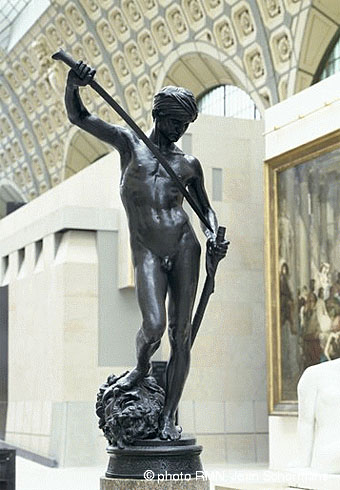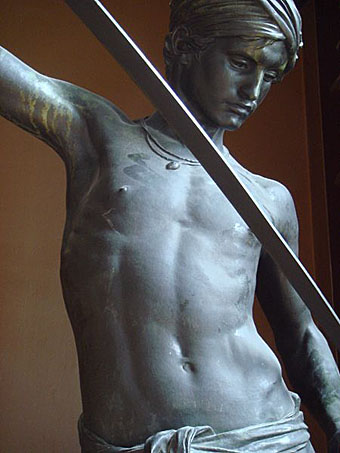David (c.1872).
I’d marked out this statue as a suitable addition to the burgeoning men with swords archive some time ago but it took the discovery of a piece of writing to prompt this post. Antonin Mercié’s statue of David resides today in the Musée d’Orsay, Paris, but I managed to miss it on my visit there. Judging by the photos it’s situated at the end of the main hall near Rodin’s enormous Gates of Hell, and it was the Rodin which claimed my attention that day. It’s also the case that the D’Orsay hall (formerly a railway station) is such a cavernous space that free-standing works such as this lose their impact, they’d look far better in smaller rooms.
At the late 1870s, Antonin Mercié incarnated the young generation of French sculptors who, without breaking away from the traditional canons, wanted to make their figures more vibrant. He sought to combine the skilled composition and lively modelling seen in the great models of the Florentine Renaissance: hence the sweeping curves of the arm extended by the movement of the sword, the bent knee, and the graceful movement of this David. A spectator walking round it can appreciate the way the planes gradually modulate the space. Mercié carved himself an original path between modern classicism and explicit realism. (More.)
You tend to find with many nude sculptures of the 19th century that the original is the naked one while the copies have gained additional items of clothing. This is the case with Mercié’s David whose replicas like the one above from the University of Copenhagen has a wrap around his waist. It’s the nude condition of the Paris statue that lends a frisson to a piece of writing by French author Patrick Drevet which may be fiction or may be reportage. An Angel at Orsay describes an elaborate game of homoerotic voyeurism as the narrator wanders through the museum and stops by Mercié’s David when he spots a student boy sketching the statue. Drevet’s piece is a sustained reverie inspired by his act of studying the student who studies the statue in turn and then becomes engaged by another student boy, the latter deliberately placing himself on view gazing at the statue and hoping (so the narrator surmises) to be sketched himself. A meagre précis like this fails to do Drevet’s piece any justice, it really needs to be read in its entirety. I found it in the Penguin Book of International Gay Writing (1995), and it may well be available in a collection of the author’s work. It’s certainly enough to make me want to read more of Drevet’s writing.
Elsewhere on { feuilleton }
• The men with swords archive
Previously on { feuilleton }
• Behold the (naked) man


